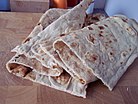| Revision as of 20:52, 28 September 2014 editJezjez11 (talk | contribs)3 editsNo edit summaryTag: gettingstarted edit← Previous edit |
Revision as of 20:54, 28 September 2014 edit undoJezjez11 (talk | contribs)3 edits →EtymologyTags: section blanking gettingstarted editNext edit → |
| Line 18: |
Line 18: |
|
'''Lavash''' ({{lang-hy|]}}; {{lang-fa|لواش}}); {{lang-tr|lavaş}}) is a soft, thin ] of Iranian origin. The word Lavash is a word in the farsi/persian language. |
|
'''Lavash''' ({{lang-hy|]}}; {{lang-fa|لواش}}); {{lang-tr|lavaş}}) is a soft, thin ] of Iranian origin. The word Lavash is a word in the farsi/persian language. |
|
The ''Encyclopedia of Jewish Food'' states that its origin is ], most probably from Iran. |
|
The ''Encyclopedia of Jewish Food'' states that its origin is ], most probably from Iran. |
|
==Etymology== |
|
|
Hrach Martirosyan tentatively connects Armenian լավաշ ''lavaš'' with dialectal լափ ''lapʿ'', լուփ ''lupʿ'', լովազ ''lovaz'' ‘palm, flat of the hand’, լափուկ ''lapʿuk'', լեփուկ ''lepʿuk'' ‘flat, polished stone for playing’, լավազ ''lavaz'' ‘very thin’ and assumes derivation from ] *''law''- ‘flat’.<ref>{{cite book|last1=Martirosyan|first1=Hrach|title=Etymological Dictionary of the Armenian Inherited Lexicon|date=2010|publisher=Brill Academic Publishers|isbn=9789004173378|page=305}}</ref> He remarks that semantically this is conceivable since this bread is specifically flat and thin. He then proceeds: |
|
|
|
|
|
|
|
|
==Background== |
|
==Background== |
|
Traditionally the dough is rolled out flat and slapped against the hot walls of a ]. While quite flexible when fresh, lavash dries out quickly and becomes brittle and hard. The soft form is easier to use when making wrap sandwiches; however, the dry form can be used for long-term storage (almost one year) and is used instead of leavened bread in ] traditions by the ]. In villages in Armenia, the dried lavash is stacked high in layers to be used later, and when the time comes to rehydrate the bread, it is sprinkled with water to make it softer again. In its dry form, left-over lavash is used in Iran to make quick meals after being rehydrated with water, butter and cheese. In Armenia the dried bread is broken up into ]. Fresh lavash is also used with ]s in Iran and the Arabian Peninsula, or ] wraps in Turkiye According to the Encyclopedia International. |
|
Traditionally the dough is rolled out flat and slapped against the hot walls of a ]. While quite flexible when fresh, lavash dries out quickly and becomes brittle and hard. The soft form is easier to use when making wrap sandwiches; however, the dry form can be used for long-term storage (almost one year) and is used instead of leavened bread in ] traditions by the ]. In villages in Armenia, the dried lavash is stacked high in layers to be used later, and when the time comes to rehydrate the bread, it is sprinkled with water to make it softer again. In its dry form, left-over lavash is used in Iran to make quick meals after being rehydrated with water, butter and cheese. In Armenia the dried bread is broken up into ]. Fresh lavash is also used with ]s in Iran and the Arabian Peninsula, or ] wraps in Turkiye According to the Encyclopedia International. |
Traditionally the dough is rolled out flat and slapped against the hot walls of a clay oven. While quite flexible when fresh, lavash dries out quickly and becomes brittle and hard. The soft form is easier to use when making wrap sandwiches; however, the dry form can be used for long-term storage (almost one year) and is used instead of leavened bread in Eucharist traditions by the Armenian Apostolic Church. In villages in Armenia, the dried lavash is stacked high in layers to be used later, and when the time comes to rehydrate the bread, it is sprinkled with water to make it softer again. In its dry form, left-over lavash is used in Iran to make quick meals after being rehydrated with water, butter and cheese. In Armenia the dried bread is broken up into Khash. Fresh lavash is also used with kebabs in Iran and the Arabian Peninsula, or dürüm wraps in Turkiye According to the Encyclopedia International.
 Varieties of lavash
Varieties of lavash
